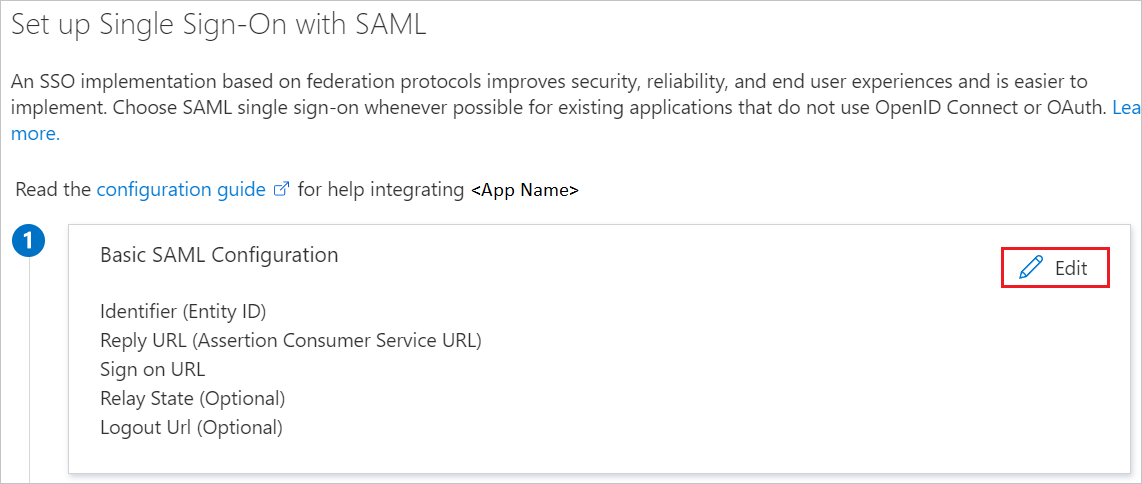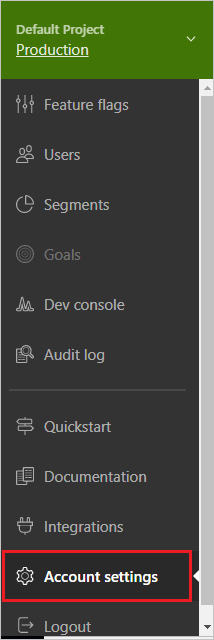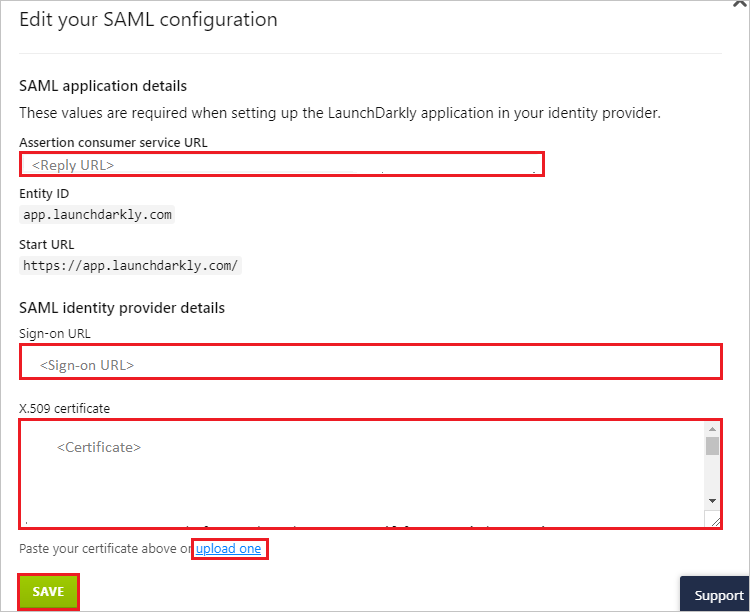Microsoft Entra integration with LaunchDarkly
In this article, you'll learn how to integrate LaunchDarkly with Microsoft Entra ID. When you integrate LaunchDarkly with Microsoft Entra ID, you can:
Control in Microsoft Entra ID who has access to LaunchDarkly.
Enable your users to be automatically signed-in to LaunchDarkly with their Microsoft Entra accounts.
Manage your accounts in one central location.
Note
The LaunchDarkly Microsoft Entra integration is one-way. After you configure the integration, you can use Microsoft Entra ID to manage users, SSO, and accounts in LaunchDarkly, but you cannot use LaunchDarkly to manage users, SSO, and accounts in Azure.
Prerequisites
The scenario outlined in this article assumes that you already have the following prerequisites:
- A Microsoft Entra user account with an active subscription. If you don't already have one, you can Create an account for free.
- One of the following roles:
- LaunchDarkly single sign-on enabled subscription.
Scenario description
In this article, you configure and test Microsoft Entra single sign-on in a test environment.
- LaunchDarkly supports IDP initiated SSO.
- LaunchDarkly supports Just In Time user provisioning.
Note
Identifier of this application is a fixed string value so only one instance can be configured in one tenant.
Add LaunchDarkly from the gallery
To configure the integration of LaunchDarkly into Microsoft Entra ID, you need to add LaunchDarkly from the gallery to your list of managed SaaS apps.
- Sign in to the Microsoft Entra admin center as at least a Cloud Application Administrator.
- Browse to Identity > Applications > Enterprise applications > New application.
- In the Add from the gallery section, type LaunchDarkly in the search box.
- Select LaunchDarkly from results panel and then add the app. Wait a few seconds while the app is added to your tenant.
Alternatively, you can also use the Enterprise App Configuration Wizard. In this wizard, you can add an application to your tenant, add users/groups to the app, assign roles, as well as walk through the SSO configuration as well. Learn more about Microsoft 365 wizards.
Configure and test Microsoft Entra SSO for LaunchDarkly
Configure and test Microsoft Entra SSO with LaunchDarkly using a test user called B.Simon. For SSO to work, you need to establish a link relationship between a Microsoft Entra user and the related user in LaunchDarkly.
To configure and test Microsoft Entra SSO with LaunchDarkly, perform the following steps:
- Configure Microsoft Entra SSO - to enable your users to use this feature.
- Create a Microsoft Entra test user - to test Microsoft Entra single sign-on with B.Simon.
- Assign the Microsoft Entra test user - to enable B.Simon to use Microsoft Entra single sign-on.
- Configure LaunchDarkly SSO - to configure the single sign-on settings on application side.
- Create LaunchDarkly test user - to have a counterpart of B.Simon in LaunchDarkly that is linked to the Microsoft Entra representation of user.
- Test SSO - to verify whether the configuration works.
Configure Microsoft Entra SSO
Follow these steps to enable Microsoft Entra SSO.
Sign in to the Microsoft Entra admin center as at least a Cloud Application Administrator.
Browse to Identity > Applications > Enterprise applications > LaunchDarkly > Single sign-on.
On the Select a single sign-on method page, select SAML.
On the Set up single sign-on with SAML page, click the pencil icon for Basic SAML Configuration to edit the settings.

On the Basic SAML Configuration section, perform the following steps:
a. In the Identifier text box, type the URL:
app.launchdarkly.comb. In the Reply URL text box, type a URL using the following pattern:
https://app.launchdarkly.com/trust/saml2/acs/<customers-unique-id>Note
The Reply URL value is not real. You will update the value with the actual Reply URL, which is explained later in the article. LaunchDarkly currently supports IDP initiated SSO. To use this application in IDP mode, you need to leave the Sign on URL field blank, otherwise you will not be able to initiate the login from the IDP. You can also refer to the patterns shown in the Basic SAML Configuration section.
On the Set up Single Sign-On with SAML page, in the SAML Signing Certificate section, click Download to download the Certificate (Base64) from the given options as per your requirement and save it on your computer.

On the Set up LaunchDarkly section, copy the appropriate URL(s) as per your requirement.

Create and assign Microsoft Entra test user
Follow the guidelines in the create and assign a user account quickstart to create a test user account called B.Simon.
Configure LaunchDarkly SSO
In a different web browser window, log into your LaunchDarkly company site as an administrator.
Select Account Settings from the left navigation panel.

Click Security tab.

Click ENABLE SSO and then EDIT SAML CONFIGURATION.

On the Edit your SAML configuration section, perform the following steps:

a. Copy the SAML consumer service URL for your instance and paste it in Reply URL textbox in LaunchDarkly Domain and URLs section on Azure portal.
b. In the Sign-on URL textbox, paste the Login URL value, which you copied previously.
c. Open the downloaded certificate into Notepad, copy the content and then paste it into the X.509 certificate box or you can directly upload the certificate by clicking the upload one.
d. Click Save.
Create LaunchDarkly test user
In this section, a user called B.Simon is created in LaunchDarkly. LaunchDarkly supports just-in-time user provisioning, which is enabled by default. There's no action item for you in this section. If a user doesn't already exist in LaunchDarkly, a new one is created after authentication.
Test SSO
In this section, you test your Microsoft Entra single sign-on configuration with following options.
Click on Test this application, and you should be automatically signed in to the LaunchDarkly for which you set up the SSO.
You can use Microsoft My Apps. When you click the LaunchDarkly tile in the My Apps, you should be automatically signed in to the LaunchDarkly for which you set up the SSO. For more information about the My Apps, see Introduction to the My Apps.
Related content
Once you configure LaunchDarkly you can enforce session control, which protects exfiltration and infiltration of your organization’s sensitive data in real time. Session control extends from Conditional Access. Learn how to enforce session control with Microsoft Defender for Cloud Apps.